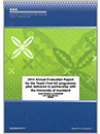This report is the second annual evaluation report for the Teach First NZ pilot programme. The first report focused on the programme’s first year, Cohort 13. This second report focuses on Year 2 for Cohort 13 and Year 1 for Cohort 14.
This 2014 evaluation confirms that, in general, the Teach First NZ programme has been implemented effectively and efficiently, and that it has benefited rather than suffered from doubling in size. Feedback from 2013 has provided the base from which to improve the programme in 2014. Teach First NZ and the University of Auckland's Faculty of Education continue to find ways to strengthen the programme and to ensure it is well known and well supported. Participants are very strong ambassadors for the programme, including the mission of reducing educational inequalities, and for secondary teaching in New Zealand. Almost all participants have achieved highly, have supported their students to do well, including in NCEA, and intend to stay in teaching at least in the short term.
Key success elements of the Teach First NZ programme are:
- the robust selection process resulting in high-calibre participants
- the responsiveness of the programme, in part made possible because of the small size of the programme, but also a consequence of the robust partnership between Teach First NZ and the Faculty of Education (hereafter referred to as the Teach First NZ partnership)
- effective support and mentoring for participants from the school and partnership personnel
- immersion in the classroom, coupled with opportunities for participants' critical reflection on themselves and their teaching.
The successful implementation of all these elements is critical for an employment-based programme. While there is variability in the way these elements play out, particularly in relation to mentoring and in-school support, in combination they provide a powerful platform for this model of an alternative pathway into secondary teaching.

